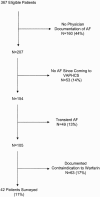Is warfarin really underused in patients with atrial fibrillation?
- PMID: 11722687
- PMCID: PMC1495287
- DOI: 10.1111/j.1525-1497.2001.10432.x
Is warfarin really underused in patients with atrial fibrillation?
Abstract
Context: There is agreement that warfarin decreases stroke risk in patients with atrial fibrillation (AF), but prior studies suggest that warfarin is markedly underused, for unclear reasons.
Objective: To determine if warfarin is underused in the treatment of patients with atrial fibrillation.
Design: Cross-sectional.
Setting: Tertiary care VA hospital.
Patients: All patients with a hospital or outpatient diagnosis of AF between 10/1/95 and 5/31/98.
Data collection: One or more physician investigators reviewed pertinent records for each patient. When any of the 3 investigators thought warfarin might be indicated, the patient's primary care provider completed a survey regarding why warfarin was not used.
Results: Of 1,289 AF patients, 844 (65%) had filled at least 1 warfarin prescription. Of the 445 remaining, 19 had died, 5 had inadequate medical records, and 54 received warfarin elsewhere, leaving 367 patients. Of these, 160 had no documented AF, 53 had only a history of AF, and 49 had only transient AF. Of the remaining 105 patients, 17 refused warfarin therapy and 72 had documented contraindications to warfarin use including bleeding risk or history, fall risk, alcohol abuse, or other compliance problems. The reasons for not using warfarin among the 16 patients remaining included provider oversight (n = 4) and various reasons suggesting provider knowledge deficits.
Conclusion: In contrast to prior studies that suggested that warfarin is markedly underused, we found that few patients with AF and no contraindication to anticoagulation were not receiving warfarin. We believe that differing study methodologies, including the use of physician review and provider survey, may explain our markedly different rate of warfarin underutilization, although local institutional factors cannot be excluded. The findings suggest that primary providers may be far more compliant with the standard of care for patients with atrial fibrillation than previously believed.
Figures
References
-
- Feinberg WM, Blackshear JL, Laupacis A, Kronmal R, Hart RG. Prevalence, age distribution, and gender of patients with atrial fibrillation. Analysis and implications. Arch Intern Med. 1995;155:469–73. - PubMed
-
- Furberg CD, Psaty BM, Manolio TA, Gardin JM, Smith VE, Rautaharju PM. Prevalence of atrial fibrillation in elderly subjects (the Cardiovascular Health Study). Am J Cardiol. 1994;74:236–41. - PubMed
-
- Wheeldon NM. Atrial fibrillation and anticoagulant therapy. Eur Heart J. 1995;16:302–12. - PubMed
-
- Wolf PA, Abbott RD, Kannel WB. Atrial fibrillation: a major contributor to stroke in the elderly. The Framingham Study. Arch Intern Med. 1987;147:1561–4. - PubMed
-
- Atrial Fibrillation Investigators. Risk factors for stroke and efficacy of antithrombotic therapy in atrial fibrillation. Analysis of pooled data from five randomized controlled trials. Arch Intern Med. 1994;154:1449–57. - PubMed
MeSH terms
Substances
LinkOut - more resources
Full Text Sources
Medical

